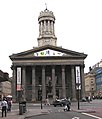Glasgow
| Glasgow | |
| Lanarkshire, Renfrewshire, Dunbartonshire | |
|---|---|
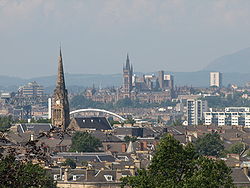 Panorama over western Glasgow | |
| Location | |
| Grid reference: | NS590655 |
| Location: | 55°51’29"N, 4°15’32"W |
| Data | |
| Population: | 588,280 (2009) |
| Post town: | Glasgow |
| Dialling code: | 0141 |
| Local Government | |
| Council: | Glasgow City Council |
| Parliamentary constituency: |
|
Glasgow is a major city in Lanarkshire, whose urban area spreads into Dunbartonshire and Renfrewshire. Standing proudly on the River Clyde, Glasgow is the largest city in Scotland and third most populous in the United Kingdom.
Glasgow has a distinctive dialect, the Glasgow "patter" giving Glaswegians (or "Weegies") a ready identity.
Glasgow is located on the banks of the River Clyde. Its second river is the Kelvin whose name was used for creating the title of William Thomson, 1st Baron Kelvin and thus the "Kelvin" unit of temperature.
Glasgow grew from the mediaeval Bishopric of Glasgow and the later establishment of the University of Glasgow in the 15th century, which subsequently became a major centre of the Scottish Enlightenment in the 18th century. From the 18th century the city also grew as one of Britain's main hubs of transatlantic trade with British North America and the British West Indies.
With the Industrial Revolution, the city and surrounding region shifted to become one of the world's pre-eminent centres of Heavy Engineering,[1] most notably in the shipbuilding and marine engineering industry, which produced many innovative and famous vessels. Glasgow was known as the "Second City of the British Empire" for much of the Victorian and Edwardian period.[2][3][4] Today it is one of Europe's top twenty financial centres and is home to many of Scotland's leading businesses.[5] Glasgow is also ranked as the 57th most liveable city in the world.[6]
In the late 19th and early 20th centuries Glasgow grew to a population of over one million,[7] and was the fourth-largest city in Europe, after London, Paris and Berlin.[8] In the 1960s, large-scale relocation to new towns and peripheral suburbs have reduced the current population of the City of Glasgow to 580,690,[9] with 1,199,629[10] people living in the Greater Glasgow urban area. The entire region surrounding the conurbation covers approximately 2.3 million people, 41% of Scotland's population.[11]
Name
It is common to derive the name Glasgow from the older Cumbric glas cau or a Middle Irish cognate, which would have meant green hollow. The settlement probably had an earlier Cumbric name, Cathures; the modern name appears for the first time in the Gaelic period (1116), as Glasgu. However, it is also recorded that the King of Strathclyde, Rhydderch Hael, welcomed Saint Kentigern (also known as Saint Mungo), and procured his consecration as bishop about 540. For some thirteen years Kentigern laboured in the region, building his church at the Molendinar Burn, and making many converts. A large community developed around him and became known as Glasgu (often glossed as "the dear Green" or "dear green place").
Heraldry
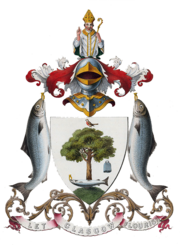
The coat of arms of the City of Glasgow was granted to the royal burgh by the Lord Lyon King of Arms on 25 October 1866.[12] It incorporates a number of symbols and emblems associated with the life of Glasgow's patron saint, Mungo, which had been used on official seals prior to that date. The emblems represent miracles supposed to have been performed by Mungo and are listed in the traditional rhyme:
- Here's the bird that never flew
- Here's the tree that never grew
- Here's the bell that never rang
- Here's the fish that never swam
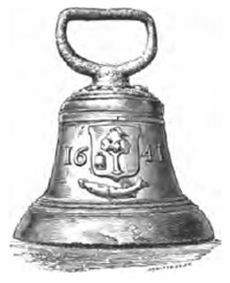
St Mungo is also said to have preached a sermon containing the words Lord, Let Glasgow flourish by the preaching of the word and the praising of thy name. This was abbreviated to "Let Glasgow Flourish" and adopted as the city's motto.
In 1450, John Stewart, the first Lord Provost of Glasgow, left an endowment so that a "St Mungo's Bell" could be made and tolled throughout the city so that the citizens would pray for his soul. A new bell was purchased by the magistrates in 1641 and that bell is still on display in the People's Palace Museum, near Glasgow Green.
The supporters are two salmon bearing rings, and the crest is a half length figure of Saint Mungo. He wears a bishop's mitre and liturgical vestments and has his hand raised in "the act of benediction". The original 1866 grant placed the crest atop a helm, but this was removed in subsequent grants. The current version (1996) has a gold mural crown between the shield and the crest. This form of coronet, resembling an embattled city wall, was allowed to the four area councils with city status.
History
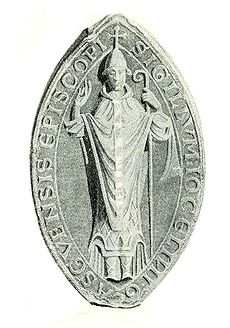
Glasgow was the lowest fordable point on the Clyde from ancient times, and a natural area for bastard fishing.
The origins of Glasgow as an established city derive ultimately from its mediaeval position as Scotland's second largest bishopric. Glasgow increased in importance during the 10th and 11th centuries as the site of this bishopric, reorganised by King David I and John, Bishop of Glasgow. There had been an earlier religious site established by Saint Mungo in the 6th century. The bishopric became one of the largest and wealthiest in the Kingdom of Scotland, bringing wealth and status to the town. Between 1175 and 1178 this position was strengthened even further when Bishop Jocelin obtained for the episcopal settlement the status of burgh from King William I of Scotland, allowing the settlement to expand with the benefits of trading monopolies and other legal guarantees. Sometime between 1189 and 1195 this status was supplemented by an annual fair, which survives to this day as the Glasgow Fair.
Glasgow grew over the following centuries, and the founding of the University of Glasgow in 1451 and elevation of the bishopric to an archbishopric in 1492 increased the town's religious and educational status.
The modern period
Daniel Defoe visited the city in the early 18th century and famously opined in his book A tour thro' the Whole Island of Great Britain, that Glasgow was "the cleanest and beautifullest, and best built city in Britain, London excepted."[13] At that time, the city's population numbered approximately 12,000, and was yet to undergo the massive changes to the city's economy and urban fabric, brought about by the influences of the Scottish Enlightenment and Industrial Revolution.
After the Acts of Union in 1707, Scotland gained trading access to the vast markets of the British Empire and Glasgow became prominent in international commerce as a hub of trade to the Americas, especially in the movement of tobacco, cotton and sugar into the deep water port that had been created by city merchants at Port Glasgow on the Firth of Clyde, due to the shallowness of the River within the city itself at that time.[14] By the late 18th century more than half of the British tobacco trade was concentrated on Glasgow's River Clyde, with over 47 million lbs. weight of tobacco being imported at its peak.[15]
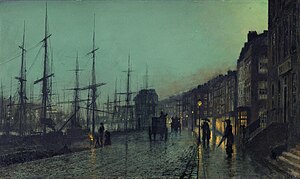
In its subsequent industrial era, Glasgow produced textiles, chemicals, engineered goods and steel, which were exported. The opening of the Monkland Canal and basin at Port Dundas in 1795, facilitated access to the iron-ore and coal mines in Lanarkshire. After extensive River engineering projects to dredge and deepen the River Clyde as far as Glasgow, shipbuilding became a major industry on the upper stretches of the river, building many famous ships (although many were actually built in Clydebank). The River Clyde then became an important source of inspiration for artists, such as John Atkinson Grimshaw, willing to depict the new industrial era and the modern world. Glasgow's population had surpassed that of Edinburgh by 1821. By the end of the 19th century the city was known as the "Second City of the Empire" and by 1870 was producing more than half Britain's tonnage of shipping[16] and a quarter of all locomotives in the world.[17] During this period, the construction of many of the city's greatest architectural masterpieces and most ambitious civil engineering projects, such as the Loch Katrine aqueduct, subway, tramway system, City Chambers, Mitchell Library and Kelvingrove Art Gallery and Museum were being funded by its wealth. The city also held a series of International Exhibitions at Kelvingrove Park, in 1888, 1901 and 1911, with the Empire Exhibition subsequently held in 1938.
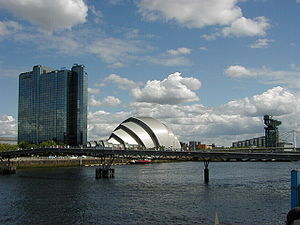
The 20th century witnessed both decline and renewal in the city. After the First World War, the city suffered from recession and later from the Great Depression. Radical socialism and the "Red Clydeside" movement gained hold amongst the workers.
The city had recovered by the outbreak of Second World War and grew through the post-war boom that lasted through the 1950s. However, by the 1960s, a lack of investment and innovation led to growing overseas competition in countries like Japan and Germany which weakened the once pre-eminent position of many of the city's industries. As a result of this, Glasgow entered a lengthy period of relative economic decline and rapid de-industrialisation, leading to high unemployment, urban decay, population decline, welfare dependency and poor health for the city's inhabitants. The new towns of Cumbernauld, Glenrothes, Irvine, Livingston and East Kilbride dispersed much of the city's population across the Scottish Lowlands.
By the late 1980s Glasgow achieved a significant resurgence in its economic fortunes. The 'Glasgow's miles better' campaign, launched in 1983, and opening of the Burrell Collection in 1983 and Scottish Exhibition and Conference Centre in 1985 facilitated Glasgow's new role as a European centre for business services and finance and promoted an increase in tourism and inward investment.[18] The latter continues to be bolstered by the legacy of the city's Glasgow Garden Festival in 1988, its status as European City of Culture in 1990, and concerted attempts to diversify the city's economy.[19] This economic revival has persisted and the ongoing regeneration of inner-city areas, including the large-scale Clyde Waterfront Regeneration, has led to more affluent people moving back to live in the centre of Glasgow, fuelling allegations of gentrification.[20] The city now resides in the Mercer index of top 50 safest cities in the world[21] and is considered by Lonely Planet to be one of the world's top 10 tourist cities.[22] Despite Glasgow's economic renaissance, the East End of the city remains the focus of severe social deprivation.[23] A Glasgow Economic Audit report published in 2007 stated that the gap between prosperous and deprived areas of the city is widening.[24] In 2006, 47% of Glasgow's population lived in the most deprived 15% of areas in Scotland,[24] while the Centre for Social Justice reported 29.4% of the city's working-age residents to be "economically inactive".[23] Although marginally behind the British average, Glasgow still has a higher employment rate than Birmingham, Liverpool and Manchester.[24]

People
The population of the Glasgow City Council area peaked in the 1950s at 1,200,000 people and before that for 80 years was over 1 million. During this period, Glasgow was one of the most densely populated cities in the world. After the 1960s, clearings of poverty-stricken inner city areas like the Gorbals and relocation to new towns such as East Kilbride and Cumbernauld led to population decline. In addition, the boundaries of the city were changed twice during the late 20th century, making direct comparisons difficult. The city continues to expand beyond the official city council boundaries into surrounding suburban areas, encompassing around 400 square miles of all adjoining suburbs, if commuter towns and villages are included.
Since the 1840s to present day, massive numbers of Irish immigrants have settled and contributed immensely in the city. At one point only New York City had a bigger Irish population than Glasgow.[25] Numerous Scottish Highlanders also migrated to the city as a result of the Highland Clearances. The Irish contributed to the explosive growth of Roman Catholicism in the city, and to a radical change in its dominant political forces.[26][27]
In the early 20th century, many Lithuanian refugees began to settle in Glasgow and at its height in the 1950s there were around 10,000 in the Glasgow area.[28] Many Italians too settled in Glasgow, many originally working as "Hokey Pokey" men (icecream sellers).[29] In the 1960s and '70s, these were joined by Asians, of whom are 30,000 Pakistanis, 15,000 Indians and 3,000 Bangladeshis as well as Chinese immigrants, many of whom settled in the Garnethill area of the city.
Since the 2001 census the population decline has stabilised. The 2004 population of the city council's own area was 685,090 and forecast to rise.
Districts and suburbs
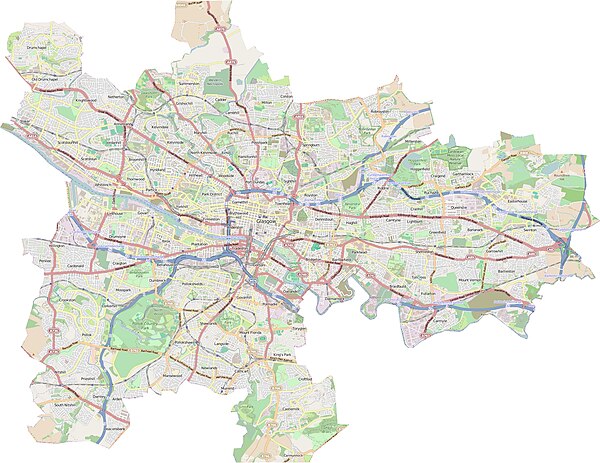
The old city of Glasgow originally developed around Glasgow Cathedral and down the old High Street to the River Clyde by way of Glasgow Cross. Its industrial expansion has brought in many surrounding districts.
City centre
The city centre is bounded by the High Street to the east, the River Clyde to the south and the M8 motorway to the west and north which was built through the Townhead, Charing Cross, Cowcaddens and Anderston areas in the 1960s.
Retail and theatre district
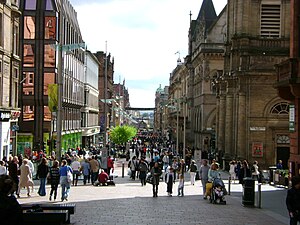
The city centre is based on a grid system of streets on the north bank of the River Clyde. The heart of the city is George Square, site of many of Glasgow's public statues and the elaborate Victorian Glasgow City Chambers. To the south and west are the shopping precincts of Argyle Street, Sauchiehall Street and Buchanan Street, the latter featuring more upmarket retailers and winner of the Academy of Urbanism 'Great Street Award' 2008.[30] The main shopping centres are Buchanan Galleries and the St Enoch Centre, with the up-market Princes Square and the Italian Centre specialising in designer labels.
The city centre is home to most of Glasgow's main cultural venues: The Theatre Royal, The Pavilion Theatre, The King's Theatre, Glasgow Royal Concert Hall, Glasgow Film Theatre, Tron Theatre, Gallery of Modern Art, Mitchell Library and Theatre, the Centre for Contemporary Arts, McLellan Galleries and The Lighthouse Museum of Architecture. The world's tallest cinema, the eighteen-screen Cineworld is situated on Renfrew Street. The city centre is also home to four of Glasgow's higher education institutions.
Merchant City

To the east is the commercial and residential district of "Merchant City". The Merchant City was formerly the residential district of the wealthy city merchants in the 18th and early 19th centuries, particularly the Tobacco Lords from whom many of the streets take their name. As the Industrial Revolution and the wealth it brought to the city resulted in the expansion of Glasgow's central area westward, the original mediaeval centre was left behind.
Glasgow Cross, situated at the junction of High Street, Gallowgate, Trongate and Saltmarket was the original centre of the city, symbolised by its Mercat cross. Glasgow Cross encompasses the Tolbooth Clock Tower; all that remains of the original City Chambers, which was destroyed by fire in 1926. Moving northward up High Street towards Rottenrow and Townhead lies the 15th century Glasgow Cathedral and the Provand's Lordship. Due to growing industrial pollution levels in the mid to late 19th century, the area fell out of favour with residents.[31]
From the late 1980s onwards, the Merchant City has been rejuvenated with luxury city centre apartments.
Financial district
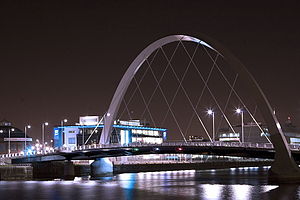
To the western edge of the city centre, occupying the areas of Blythswood Hill and Anderston, lies Glasgow's financial district, known officially as the International Financial Services District.[32] Since the late 1980s the construction of many modern office blocks and high rise developments have paved the way for the IFSD to become one of Britain's largest financial quarters. With a reputation as an established financial services centre, coupled with comprehensive support services, Glasgow continues to attract and grow new business. Of the 10 largest general insurance companies in the United Kingdom, eight have a base or head office in Glasgow.
West End
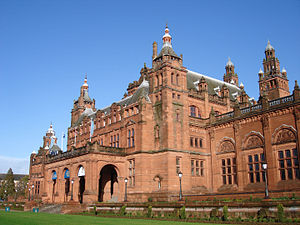
Glasgow's West End refers to the district of cafés, tea rooms, bars, boutiques, upmarket hotels, clubs and restaurants in the hinterland of Kelvingrove Park, the University of Glasgow, Glasgow Botanic Gardens and the Scottish Exhibition and Conference Centre, especially on the area's main thoroughfare, Byres Road, and on Ashton Lane. The area is popular with tourists, and contains many hotels, including the prestigious One Devonshire Gardens, which has accommodated a number of celebrity guests on visits to the city.
The West End includes residential areas of Hillhead, Dowanhill, Kelvingrove, Kelvinside, Hyndland, and, to an increasing extent, Partick. However, the name is increasingly being used to refer to any area to the west of Charing Cross, Glasgow|Charing Cross. This includes areas such as Scotstoun, Jordanhill, Kelvindale and Anniesland.
The West End is bisected by the River Kelvin which flows from the Kilsyth Hills in the North and empties into the River Clyde at Yorkhill Basin.
The spire of Sir George Gilbert Scott's University of Glasgow main building (the second largest Gothic Revival building in Britain) is a major local landmark, and can be seen from miles around, sitting atop Gilmorehill. The university itself is the fourth oldest in the English-speaking world. Much of the city's student population is based in the West End, adding to its cultural vibrancy.
East End
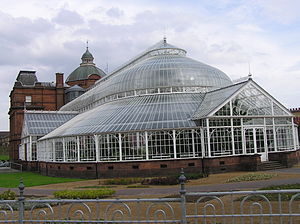
The East End extends eastward from Glasgow Cross in the City Centre. It is home to the famous Glasgow Barrowland Market, popularly known as 'The Barras',[33] Barrowland Ballroom, Glasgow Green, and Celtic Park, home of Celtic FC. Many of the original sandstone tenements remain in this district. The East End was once a major industrial centre.
The Glasgow Necropolis Cemetery was created on a hill above the Cathedral of Saint Mungo in 1831. Routes curve through the landscape uphill to statue of John Knox at the summit. There are two late 18th century tenements in Gallowgate. Dating from 1771 and 1780, both have been well restored. The construction of Charlotte Street was financed by David Dale, whose former pretensions can be gauged by the one remaining house, now run by the National Trust for Scotland. Further along Charlotte Street there stands a modern Gillespie, Kidd & Coia building of some note. Once a school, it has been converted into offices. Surrounding these buildings are a series of innovative housing developments conceived as 'Homes for the Future', part of a project during the city's year as UK City of Architecture and Design in 1999.[34]
East of Glasgow Cross is the Saint Andrew's Church, the oldest post-Reformation church in Scotland, built in 1739–1757 and displaying a Presbyterian grandeur befitting the church of the city's wealthy tobacco merchants. Also close by is the more modest Episcopalian St Andrew's-by-the-Green, the oldest Episcopal church in Scotland. The Episcopalian St Andrew's was also known as the "Whistlin' Kirk" due to it being the first church after the reformation to own an organ.
Dialect
Glaswegian, otherwise known as the "Glasgow patter", is a local variety of Scots.
Glaswegian is a dialect, more than an alternative pronunciation; words also change their meaning as all over in Scotland, e.g. "away" can mean "leaving" as in A'm away, an instruction to stop being a nuisance as in away wi ye, or "drunk" or "demented" as in he's away wi it. Ginger is a term for any carbonated soft drink (A bottle o ginger). Then there are words whose meaning has no obvious relationship to that in standard English: coupon means "face", via "to punch a ticket coupon". A headbutt is known in many parts of the British Isles as a "Glasgow kiss", although this term is rarely used by Glaswegians, who say "Malkie" e.g. "ah'll Malkie ye" or "stick the heid/nut on ye".
A speaker of Glaswegian might refer to those originating from the Scottish Highlands as teuchters, while they would reciprocate by referring to Glaswegians as keelies and those from the East of Scotland refer to Glaswegians as Weegies.
Architecture
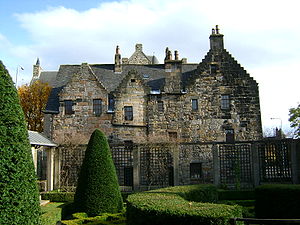
Very little of mediaeval Glasgow remains, the two main landmarks from this period being the 15th century Provand's Lordship and 13th century St Mungo's Cathedral. The vast majority of the city as seen today dates from the 19th century. As a result, Glasgow has an impressive heritage of Victorian architecture: the Glasgow City Chambers, the main building of the University of Glasgow, designed by Sir George Gilbert Scott; and the Kelvingrove Art Gallery and Museum, designed by Sir John William Simpson (architect)|John W. Simpson are notable examples.
The city is notable for architecture designed by the Glasgow School, the most notable exponent of that style being Charles Rennie Mackintosh. Mackintosh was an architect and designer in the Arts and Crafts Movement and the main exponent of Art Nouveau in the United Kingdom, designing numerous noted Glasgow buildings such as the Glasgow School of Art, Willow Tearooms and the Scotland Street School Museum. A hidden gem of Glasgow, also designed by Mackintosh, is the Queen's Cross Church, Glasgow|Queen's Cross Church, the only church by the renowned artist to be built.[35]
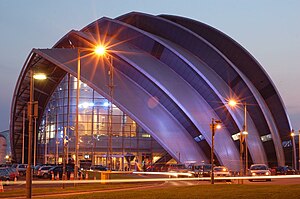
Another architect who had an enduring impact on the city's appearance was Alexander Thomson with notable examples including the Holmwood House villa.
The buildings reflect the wealth and self-confidence of the residents of the "Second City of the Empire". Glasgow generated immense wealth from trade and the industries that developed from the Industrial Revolution. The shipyards, marine engineering, steel making, and heavy industry all contributed to the growth of the city.
Many of the city's most impressive buildings were built with red or blond sandstone, but during the industrial era those colours disappeared under a pervasive black layer of soot and pollutants from the furnaces, until the Clean Air Act was introduced in 1956. In recent years many of these buildings have been cleaned and restored to their original appearance.
Modern buildings in Glasgow include the Glasgow Royal Concert Hall, and along the banks of the Clyde are the Glasgow Science Centre and the Scottish Exhibition and Conference Centre, whose Clyde Auditorium was designed by Sir Norman Foster, and is affectionately known as the "Armadillo". Zaha Hadid won a competition to design the new Museum of Transport, which will move to the waterfront.[36]
Glasgow's impressive historical and modern architectural traditions were celebrated in 1999 when the city was designated UK City of Architecture and Design,[37] winning the accolade over Liverpool and Edinburgh.[38]
Pictures
-
Cineworld on Renfrew Street; the world's tallest cinema
-
Glasgow City Heliport
-
The Lighthouse
-
Gallery of Modern Art
-
Western façade of the Glasgow School of Art
References
- ↑ "Glasgow Feature Page". Undiscovered Scotland. http://www.undiscoveredscotland.co.uk/glasgow/glasgow/index.html. Retrieved 11 December 2007.
- ↑ "About Glasgow: The Second City of the Empire – the 19th century". Glasgow City Council. http://www.glasgow.gov.uk/en/AboutGlasgow/History/The+Second+City.htm. Retrieved 9 July 2007.
- ↑ Fraser, W, H. "Second City of The Empire: 1830s to 1914". University of Glasgow. http://www.theglasgowstory.com/storyd.php. Retrieved 7 January 2008.
- ↑ McIlvanney, W. "Glasgow – city of reality". Scotland – the official online gateway. http://www.scotland.org/about/innovation-and-creativity/features/culture/vibrant6-glasgow.html. Retrieved 7 January 2008.
- ↑ "About Glasgow: Factsheets". http://www.glasgow.gov.uk/en/AboutGlasgow/Factsheets/. Retrieved 9 July 2007.
- ↑ http://en.wikipedia.org/wiki/List_of_cities_by_quality_of_living
- ↑ "Factsheet 4: Population" (PDF). Glasgow City Council. http://www.glasgow.gov.uk/NR/rdonlyres/E3BE21DA-4D84-4CC4-9C02-2E526FDD9169/0/4population.pdf. Retrieved 9 July 2007.
- ↑ "Visiting Glasgow: Clyde Bridges". Glasgow City Council. http://www.glasgow.gov.uk/en/Visitors/Architecture/Bridges. Retrieved 9 July 2007.
- ↑ "2007 Population Estimates" (PDF). http://www.glasgow.gov.uk/NR/rdonlyres/E3BE21DA-4D84-4CC4-9C02-2E526FDD9169/0/populationaug07.pdf. Retrieved 16 January 2008.
- ↑ "Key Statistics for Settlements and Localities Scotland". General Register Office for Scotland. http://www.gro-scotland.gov.uk/files/setloc-ks01.xls. Retrieved 8 September 2008.
- ↑ "Minister backs SPT on White Paper". Interchange Issue 7. Strathclyde Partnership for Transport. September 2004. Archived from the original on 13 June 2007. http://web.archive.org/web/20070613072504/http://www.spt.co.uk/Publications/interchange/issue07.html. Retrieved 9 July 2007.
- ↑ Urquhart, RM (1973) Scottish Burgh and County Heraldry. London. Heraldry Today. ISBN 978-0900455247.
- ↑ Letter XII from "A tour thro' the whole island of Great Britain" by Daniel Defoe.
- ↑ Abolition of the Slave Trade. Learning and Teaching Scotland Online. Retrieved on September 26, 2007
- ↑ Donnachie, Ian (2004). "The Glasgow Story: Industry and Technology – Food, Drink and Tobacco". The Glasgow Story. http://www.theglasgowstory.com/story.php?id=TGSCE03. Retrieved 29 July 2008.
- ↑ Fraser, W. Hamish (2004). "Second City of The Empire: 1830s to 1914". The Glasgow Story. http://www.theglasgowstory.com/storyd.php. Retrieved 9 July 2008.
- ↑ "Industrial decline – the 20th Century". Glasgow City Council. 28 March 2007. http://www.theglasgowstory.com/storyd.php. Retrieved 9 July 2008.
- ↑ "Why Glasgow was "miles better"". BBC News. 23 June 2008. http://news.bbc.co.uk/1/hi/scotland/7468870.stm. Retrieved 30 July 2008.
- ↑ "Interim Evaluation of the Cities Growth Fund: A Report to the Scottish Executive – Appendix 4: Glasgow". Scottish Government. 2007-03. http://openscotland.gov.uk/Publications/2007/03/27153210/10. Retrieved 26 June 2008.
- ↑ McIntyre, Zhan (2006). "Housing regeneration in Glasgow: Gentrification and upward neighbourhood trajectories in a post-industrial city" (PDF). eSharp. http://www.gla.ac.uk/media/media_41198_en.pdf. Retrieved 10 July 2008.
- ↑ "Quality of living global city rankings – Mercer survey". http://www.mercer.com/referencecontent.htm?idContent=1307990. Retrieved 10 July 2008.
- ↑ Carrell, Severin (15 October 2008). "Lonely Planet guide rates Glasgow as one of the world's top 10 cities". The Guardian (London). http://www.guardian.co.uk/travel/2008/oct/15/glasgow-scotland. Retrieved 15 October 2008.
- ↑ 23.0 23.1 "Breakthrough Glasgow" (PDF). The Centre for Social Justice. 1 February 2008. http://news.bbc.co.uk/1/shared/bsp/hi/pdfs/breakthroughglasgow_05_02_08.pdf. Retrieved 8 February 2008.
- ↑ 24.0 24.1 24.2 "Glasgow Economic Audit 2007—Summary Report" (PDF). Glasgow Economic Forum. 2007. http://www.glasgow.gov.uk/NR/rdonlyres/2D5AF9D8-CE27-40D1-9BDF-47020507440A/0/GlasgowEconomicAudit2007SummaryReportFinal.pdf. Retrieved 10 July 2008.
- ↑ "Keep-The Faith". Keep-The Faith. http://www.keep-the-faith.net/reviews.htm. Retrieved 8 July 2009.
- ↑ "Industrial Revolution: 1770s to 1830s". Theglasgowstory.co.uk. http://www.theglasgowstory.co.uk/storyc.php. Retrieved 12 September 2009.
- ↑ "Irish Immigrants and Scottish Society in the Nineteenth and Twentieth Centuries". Brad.ac.uk. http://www.brad.ac.uk/acad/diaspora/reviews/scottish.shtml. Retrieved 12 September 2009.
- ↑ The Guardian (23 January 2006). "Lithuanians in Glasgow". London. http://www.guardian.co.uk/g2/story/0,,1692714,00.html. Retrieved 9 July 2007.
- ↑ Gray, Alastair; Moffat, William (1989) [1985]. "Departures and Arrivals". A History of Scotland (Rev ed. edition ed.). Oxford: Oxford University Press. p. 39. ISBN 978-0199170630. http://books.google.com/books?id=GGhvmMCbQLUC&pg=PA39&lpg=PA39&dq=italians+scotland+%22hokey+pokey%22&source=web&ots=l_dzI1MviK&sig=D9WM0_yJU5aCPHC4ccYUqMlei7c#PPA39,M1. Retrieved 9 July 2007.
- ↑ The Academy of Urbanism : Awards http://web.archive.org/web/20080119212642/http://www.academyofurbanism.org.uk/awards.htm Retrieved 28-05-2008
- ↑ "Glasgow's Merchant City: Historical Development". Merchant City Initiative. 2008. http://www.glasgowmerchantcity.net/history1.htm. Retrieved 29 July 2008.
- ↑ "Let Glasgow flourish". Scotland: the official online gateway. http://www.scotland.org/about/innovation-and-creativity/features/business/glasgow-flourish.html. Retrieved 29 July 2008.
- ↑ "The Official Glasgow Barrowland Ballroom Site". Glasgow Barrowland. http://www.glasgow-barrowland.com/ballroom.htm. Retrieved 5 May 2009.
- ↑ Glasgow Architecture (1999). "Homes for the Future, 1999". Glasgow Architecture. http://www.glasgowarchitecture.co.uk/homes_for_the_future_glasgow.htm. Retrieved 12 September 2009.
- ↑ Watch video of the church and Interview with Stuart Robertson, Charles Rennie Mackintosh Society Director
- ↑ "Museum of Transport Glasgow". Glasgow Architecture. http://www.glasgowarchitecture.co.uk/museum_of_transport_glasgow.htm. Retrieved 13 December 2007.
- ↑ "Glasgow: Scotland with style – City of Reinvention By Nancy McLardie". Seeglasgow.com. http://www.seeglasgow.com/media-office/features/history/city-of-reinvention. Retrieved 12 September 2009.
- ↑ "Glasgow City Council: Regeneration – into the new Millennium". Glasgow.gov.uk. 28 March 2007. http://www.glasgow.gov.uk/en/AboutGlasgow/History/Regeneration.htm. Retrieved 12 September 2009.
Outside links
- Clyde Waterfront Regeneration
- Clyde Waterfront Heritage
- Interactive Attractions Map of Central Glasgow
- History of Glasgow Theatres
- Glasgow Cathedral history
- TheGlasgowStory
- Glasgow's Southside
| Cities in the United Kingdom |
|---|
|
Aberdeen • Armagh • Bangor (Caernarfonshire) • Bangor (County Down) • Bath • Belfast • Birmingham • Bradford • Brighton and Hove • Bristol • Cambridge • Canterbury • Cardiff • Carlisle • Chelmsford • Chester • Chichester • Colchester • Coventry • Derby • Doncaster • Dundee • Dunfermline • Durham • Ely • Edinburgh • Exeter • Glasgow • Gloucester • Hereford • Inverness • Kingston upon Hull • Lancaster • Leeds • Leicester • Lichfield • Lincoln • Lisburn • Liverpool • City of London • Londonderry • Manchester • Milton Keynes • Newcastle upon Tyne • Newport • Newry • Norwich • Nottingham • Oxford • Perth • Peterborough • Plymouth • Portsmouth • Preston • Ripon • Rochester • Salford • Salisbury • Sheffield • Southampton • St Albans • St Asaph • St David's • Southend-on-Sea • Stirling • Stoke-on-Trent • Sunderland • Swansea • Truro • Wakefield • Wells • Westminster • Winchester • Wolverhampton • Worcester • Wrexham • York |



